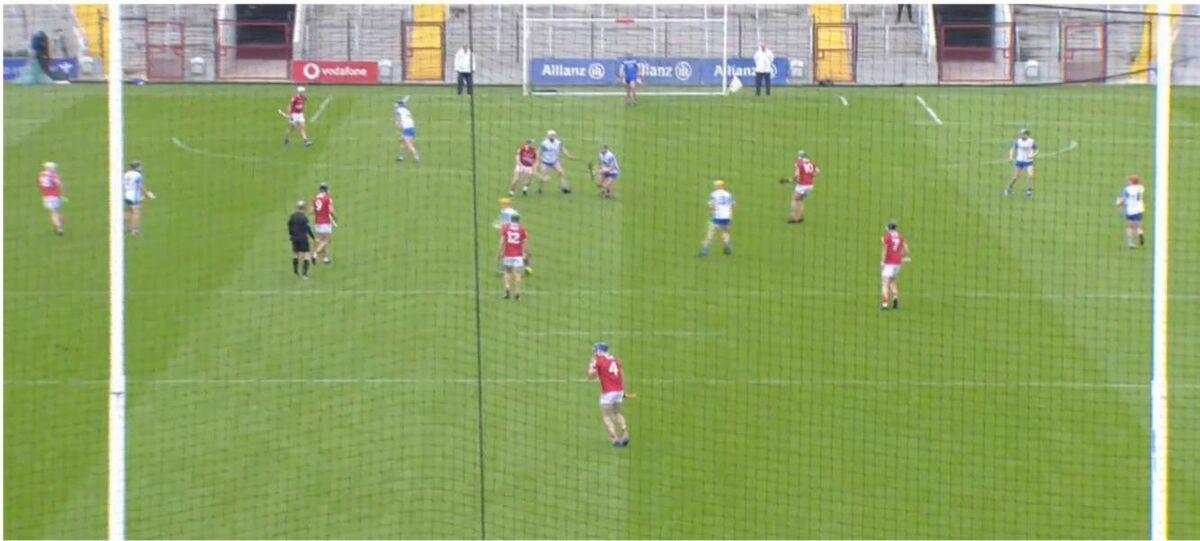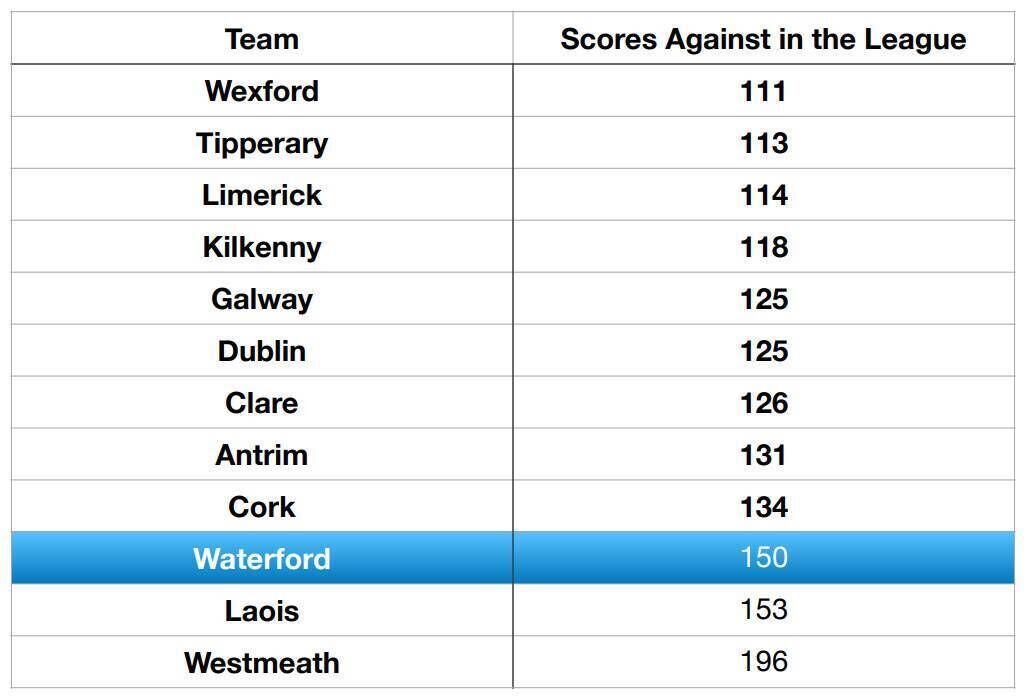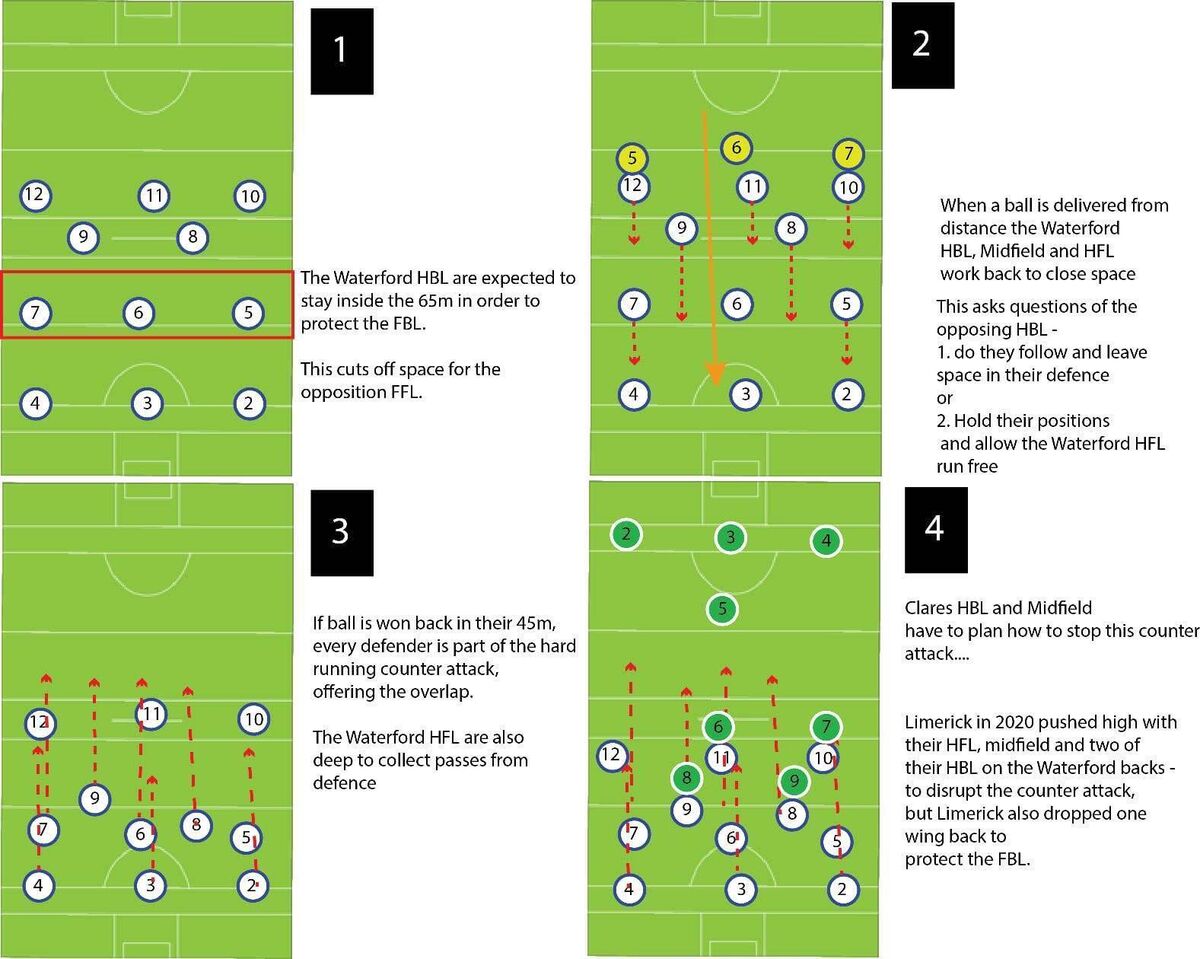Hurling Tactics Board: Waterford's counter-attack and the key to stopping it

Graphics by Sean Flynn
In the 2021 Allianz Hurling League, Waterford showcased their counter-attacking brand of hurling that resulted in them scoring 3-41 (49), which was one-third of their overall scores in the league.
Their counter-attacking game involves the Déise men turning over possession inside their 45-yard line and working possession up the field with their runners out of the defence to create a shooting opportunity from distance.
This method of attack also gives Waterford an opportunity to work the ball to an area where they can deliver to their full-forward line.

This type of gameplan relies on their half-back line holding their positions when out of possession and relies on their midfield and half-forwards working back into their own half during play.
The half-backs hold their positions to protect their full-back line and ensure that they have bodies in their own third of the pitch when a turnover is made in order to create the conditions for a counter-attack.
When Waterford win a turnover and gain possession, all of their players that have dropped deep must run hard in and out of possession to create lines of sight for handpasses and stick passes.
Also, when Waterford win back possession their backs have the licence to attack and the number on their backs jersey does not hinder their ability to be an option for a player in possession.

Waterford are able to catch teams on the back foot as midfield and defences do not have the time to reset due to possession being turned over so quickly from their deliveries from distance.
When Waterford played Tipperary in this year's league they scored 2-14 (20) from this counter-attacking ploy. And in the second half of their All-Ireland semi-final against Kilkenny last season, they scored eights points.
When these turnovers occur, defences are less organised, lack shape and do not have the time to reset, which allows Waterford to use their speed and offloading game to attack.
The requirement to overcommit runners off the ball when in possession leaves Waterford open to be countered themselves when the play breaks down.
The risk and reward nature of this style can be seen in the scores against table for the 2021 league, which saw Waterford concede the third most of any team.

The concession of goals throughout the league and in some of their championship games may be of concern to Liam Cahill and his management team. In the 2021 league, Waterford conceded on average 2.6 goals per game and they conceded three goals against their upcoming opponents in the championship when they played in the 2020 All-Ireland quarter-final.
If Waterford’s counter-attacking performances against Limerick in their last three games are analysed, it suggests that the Treaty men’s method of defending and use of the ball protects them against the Déise ploy. In over 210 minutes of game-time Waterford scored only 12 points in total from turning over Limerick possession inside the Waterford 45 yard line.

A simple analysis would suggest that it is the manic workrate of the Limerick team that is key, making over 100 tackles out of possession. But it's also true that when they are in possession Limerick shoot from distance which results in little possession being hit inside the Waterford 45-yard line.
Looking deeper into these games, the organisation and commitment to press up on the Waterford players helps Limerick to nullify the counter-attacking game.
John Kiely's side organise their wing-backs and midfield to press or man-mark the Waterford players on the side of the pitch where the play is developing.
The Limerick wing-back on the opposite side of the pitch sits back in the Limerick half and will be there to pick up any breaks or read any long deliveries out from the Waterford half.
This method of defending high up the pitch prevents Waterford working possession out of their defence, creates rucks, and reduces the space for Waterford players to run off the shoulder for a pass as all the players are in close proximity to each other.

By forcing Waterford players to deliver the ball from inside their half under pressure or break down their running game out of defence creates a Limerick counter-attack of their own.
The Limerick players are either winning possession back in the Waterford half and creating scoring opportunities for their forwards or their backs who sit back to regain long deliveries can take advantage of the space created by the Waterford midfield and half forwards going deep into their own half.
This could be seen in the scoring rate from play of the Limerick players in the 2020 All-Ireland final, which saw Gearóid Hegarty score 0-7, Tom Morrissey 0-5, Aaron Gillane 0-4, Seamus Flanagan 0-3, Diarmuid Byrnes 0-1, Kyle Hayes 0-1 and Declan Hannon 0-1.

It looks like Brian Lohan's preferred half-back line and midfield would consist of David McInerney, John Conlon, Diarmuid Ryan, Colm Galvin and Tony Kelly if they are all fit.
Nobody can question these players' ability in possession to work the ball and get scores, but what will be tested is their ability to press Waterford players out of possession.
The positioning and press of McInerney, Conlon and Ryan will be vital to protecting the Clare full back-line and stopping Waterford’s shots from distance when on the counter.
The 2020 championship fixture saw Waterford score ten points from their counter-attack. Clare's method of defence and attack in the middle third will be one of the main factors deciding which team qualifies for the Munster semi-final against Tipperary on July 4th.










